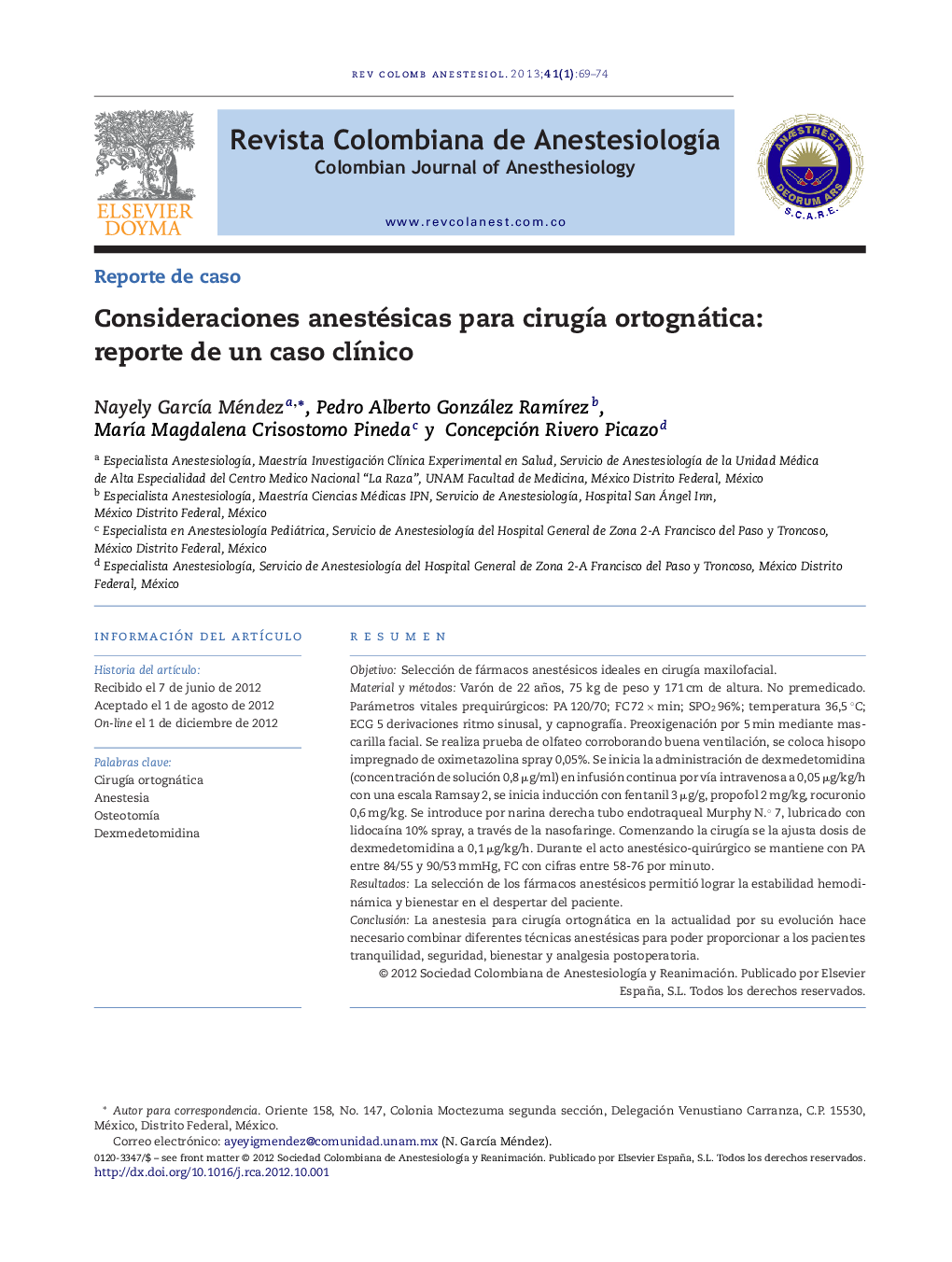| Article ID | Journal | Published Year | Pages | File Type |
|---|---|---|---|---|
| 2767715 | Revista Colombiana de Anestesiología | 2013 | 6 Pages |
ResumenObjetivoSelección de fármacos anestésicos ideales en cirugía maxilofacial.Material y métodosVarón de 22 años, 75 kg de peso y 171 cm de altura. No premedicado. Parámetros vitales prequirúrgicos: PA 120/70; FC 72 × min; SPO2 96%; temperatura 36,5 °C; ECG 5 derivaciones ritmo sinusal, y capnografía. Preoxigenación por 5 min mediante mascarilla facial. Se realiza prueba de olfateo corroborando buena ventilación, se coloca hisopo impregnado de oximetazolina spray 0,05%. Se inicia la administración de dexmedetomidina (concentración de solución 0,8 μg/ml) en infusión continua por vía intravenosa a 0,05 μg/kg/h con una escala Ramsay 2, se inicia inducción con fentanil 3 μg/g, propofol 2 mg/kg, rocuronio 0,6 mg/kg. Se introduce por narina derecha tubo endotraqueal Murphy N.° 7, lubricado con lidocaína 10% spray, a través de la nasofaringe. Comenzando la cirugía se la ajusta dosis de dexmedetomidina a 0,1 μg/kg/h. Durante el acto anestésico-quirúrgico se mantiene con PA entre 84/55 y 90/53 mmHg, FC con cifras entre 58-76 por minuto.ResultadosLa selección de los fármacos anestésicos permitió lograr la estabilidad hemodinámica y bienestar en el despertar del paciente.ConclusiónLa anestesia para cirugía ortognática en la actualidad por su evolución hace necesario combinar diferentes técnicas anestésicas para poder proporcionar a los pacientes tranquilidad, seguridad, bienestar y analgesia postoperatoria.
ObjectiveSelection of ideal anesthetic drugs in maxillofacial surgery.Material and methodsA 22-year-old male patient weighing 75 kg and 171 cm in height, with no premedication. Pre-operative vital parameters were BP 120/70, HR 72× min, SpO2 96%, temperature 36.5 °C, sinus rhythm on 5-lead EKG, capnograpy. The patient was subjected to 5 min of pre-oxygenation through a facial mask. The sniff test was performed, good ventilation was confirmed and a Q-tip impregnated in 0.05% oxymetazoline was applied. An intravenous continuous infusion of dexmedetomidine (solution concentration of 0.8 cg/ml) was initiated at a rate of 0.05 mcg/kg/h with a score of 2 on the Ramsay scale. Induction was initiated with fentanyl 3 mcg/kg, propofol 2 mg/kg, rocuronium 0.6 mg/kg. A No. 7 Murphy endotracheal tube lubricated with a 10% lidocaine spray was introduced through the right nostril down to the nasopharynx. At the start of surgery, the dose of dexmedetomidine was increased to 0.1 mcg/kg/h. Intra-operatively, BP was maintained between 84/55 mmHg and 90/53 mmHg, and HR between 58 and 76 per minute.ResultsThe selection of anesthetic drugs allowed for hemodynamic stability and comfort on awakening.ConclusionAnesthesia for orthognathic surgery, as it has evolved today, requires combining different anesthetic techniques in order to ensure that the patient remains calm, comfortable and reassured, with adequate post-operative analgesia.
